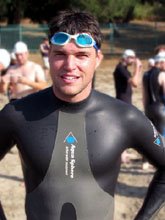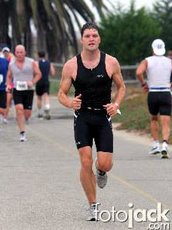So I was reading THE OPRAH MAGAZINE yesterday--and there’s nothing wrong with that--and came across an article by Selene Yeager called “Exercise: The Least You Can Do (Would You Believe Ten Minutes?)”. Like most pieces on exercise in that publication, it’s short—and there’s nothing wrong with that, either. I have to remind myself sometimes that the vast majority of the population doesn’t derive a huge portion of their happiness and fulfillment from exercising and thinking about exercising and wondering how and when they’ll be exercising next. It’s to Oprah’s credit that, although she makes no secret of being something of a workout-phobe herself, she nevertheless emphasizes its importance, both in print and on her TV show.
The thesis of the piece is that, contrary to the claims of fitness experts, you only have to work out about ten minutes a day to see some good results. The evidence presented is a study by Dr. Tim Church of Pennington Biomedical Research Center in Baton Rouge, which, according to the article, demonstrates that, among formerly sedentary, overweight, postmenopausal women, a low-intensity, low-duration exercise program (72 minutes per week of walking 2-3 mph) “significantly improved heart strength and general fitness, nearly matching the efforts of women exercising almost twice as long” (the same study, which was conducted in May, also received coverage here).
To her credit, Yeager does state that you will ultimately need more than ten minutes a day to affect weight loss, blood pressure, and other health indicators. She’s careful to point out that Church’s findings suggest not that the ten-minute minimum is all you’ll ever need for optimal health and fitness, but rather you can “take your time easing into those longer workouts.”
I fear, however, that the title of the piece—and pictures of the svelte, sprightly, and decidedly pre-menopausal woman that accompany the article—will upstage that relatively subtle qualification.
Taking a cue from the Sir Thomas More of Fitness, Lou Schuler, I found my way to a more comprehensive summary of Church’s study and did a little critical analysis: did the study show what Yeager suggested it did?
The answer is a qualified yes. According to the JAMA abstract of the study from May 15, 2007,
"Participants were randomly assigned to 1 of 4 groups: 102 to the nonexercise control group, 155 to the 4-kcal/kg (400 calories), 104 to the 8-kcal/kg (800 calories), and 103 to the 12-kcal/kg (1,200 calories) per week energy-expenditure groups for the 6-month intervention period. Target training intensity was the heart rate associated with 50 percent (a modest intensity) of each woman’s peak VO2 (a measure of oxygen consumption and fitness level).
The average minutes of exercising per week were 72.2 for the 4-kcal/kg, 135.8 for the 8-kcal/kg, and 191.7 for the 12-kcal/kg per week exercise groups. Compared with the control group, the VO2abs (absolute) increased by 4.2 percent in the 4-kcal/kg, 6.0 percent in the 8-kcal/kg, and 8.2 percent in the 12-kcal/kg per week groups. There were no significant changes in systolic or diastolic blood pressure values from baseline to 6 months in any of the exercise groups vs. the control group.
So, to sum up: the minimal exercise group saw an increase in VO2 max—a reliable gauge of cardiovascular fitness—of 4.2 percent over six months. Yeager claims that the low-duration group’s results “nearly matched” those of the group that exercised “nearly twice as long,” presumably the one which did their mall-stroll for 2.25 hours per week and saw an increase in VO2 max of 6.0 percent.
Now, the difference between 4.2 percent and 6.0 may not seem like much. But when we’re talking about such relatively small increments, the difference between an improvement of 4.2 percent and one of 6.0 percent IS significant: to be precise, it’s a 30 percent difference (4.2 + [30% X 4.2] = 6.0). Improve your income or your lifespan or your bench press or any other number you stress over by thirty percent and tell me you won’t be turning somersaults. A 30% better result is a MUCH BETTER RESULT. And the group that exercised for something close to a reasonable weekly duration (though still far short of a reasonable intensity) experienced an average VO2 max improvement of 8.2 percent, more than double the results of the minimal exercise group (Yeager doesn’t mention that group). So the implication that Church’s study suggested that there was no important difference in the results obtained by women exercising for 72 minutes a week and those of the women exercising nearly twice or three times as long is misleading.
Let’s be clear here: none of the groups experienced an appreciable improvement in fitness compared to what they could have experienced had their exercise program been progressive, challenging, coupled with a careful diet, and all those other things that I drone on and on about all day every day until everyone around me becomes a drooling automaton. Yeager states that the fitness levels of the minimal-exercise group improved “significantly,” but doesn’t tell us the numbers. And I suspect that even Dr. Tim Church would agree with me that, although the improvements of all three groups were “significant” in the science-class sense of “measurable,” they were almost certainly not “significant” in the common-parlance sense of “large” or “impressive” or “Gee, Marge, how’d you get to be a size four?”
A 4.2 percent increase in VO2 max—with NO attendant weight loss and NO improvement in blood pressure—might mean a lot to Lance Armstrong fine-tuning his training for Tour #8, but for someone with as far to go as these sedentary, overweight, postmenopausal women have, it just isn’t a whole lot to get excited about. So that when Church and his science buddies say that his minimal-exercise group saw a “significant” improvement in fitness, he’s really just saying that they improved enough so that, given the sample size, the improvement probably couldn’t be explained away by margin of error. It was a statistically significant improvement—not a relatively large improvement overall.
The other aspect of this study that warrants some underscoring is that we are talking about a group of people going from COMPLETELY INACTIVE to SLIGHTLY ACTIVE. Speaking as someone with some experience in the matter, There Is No More Significant Improvement to be seen than in a trainee who is going from “zero” to “some physical activity,” regardless of what that physical activity is.
That’s why I love completely sedentary clients. As long as I don’t overtrain them, they think I’m some kind of magician, because the pounds MELT off them. Relative to their couch-potato selves, they feel ASTOUNDING. Their mood soars, their mind feels clear, they sleep at night, there’s a spring in their step. EVERYONE tells them how good they look, they want to adopt me and entrust me with their personal fortunes.
But the fact is that they probably would have seen similar results if they’d bought themselves a golden retriever and walked it around the block a couple of times a day. The real test—and I realize that such tests are woefully impractical—are longer term. What will happen to the fitness levels of these women after one or two years? Would they keep improving? Or, more likely, would their fitness level off and finally even backslide?
Now look: the last thing I’d Ever Want To Do In My Life is take on Oprah, or a friend, relative, or employee of Oprah’s. Mongo only pawn in game of life. So I’m not going to get on a soap-box about how the popular media misrepresents science, and the abstract-reading and study interpretation should be left to chest-pounding, bicep-flexing fitness gurus like me. As I said, Yeager DOES judiciously qualify the implications of her splashy headline and the eye-catching accompanying photos, and if she does perhaps selectively share the facts of the study with her readers, she never outright distorts them.
The point I’m going to end with here is that the message of the Oprah magazine, and many others like it, is that Success and Happiness are Within Your Reach. You can do it. You go, girl. You don’t NEED to be a zillionaire to make a difference. With a little know-how and get-up-and-go, you can fix your lousy marriage, your bad finances, your indiscriminate diet, your figure, your dysfunctional family. And you can do so with a minimum of effort.
Truly, there’s nothing wrong with that message if it encourages people to take charge of their lives, to be more active in solving their problems, and to take positive steps towards living the life they want to lead. Having taken those first few tentative steps, the hope is that more and bolder actions will follow. And if and when they do, the results can indeed be impressive and commendable.
But let’s not kid ourselves: improving your fitness slightly, if you are sedentary, may not take much, but getting in exceptional shape is TOUGH. You’ve got to work at it, make it a priority, figure out creative ways to squeeze it in when you get busy, keep at it in spite of obstacles and setbacks. No one knows that better than Oprah herself. And by suggesting that it’s actually EASY, that impressive results are attainable with a minimum of effort—are we not setting people up for disappointment?
I just ask. Comments welcome.
Subscribe to:
Post Comments (Atom)




1 comment:
telling people fitness is easy is always setting them up for disappointment. of course, the whole world is looking for a quick fix, and magazines play into that. if that's what women want, give it to them.
with a 10 minute workout you'll soon look like jessica biel!
Post a Comment